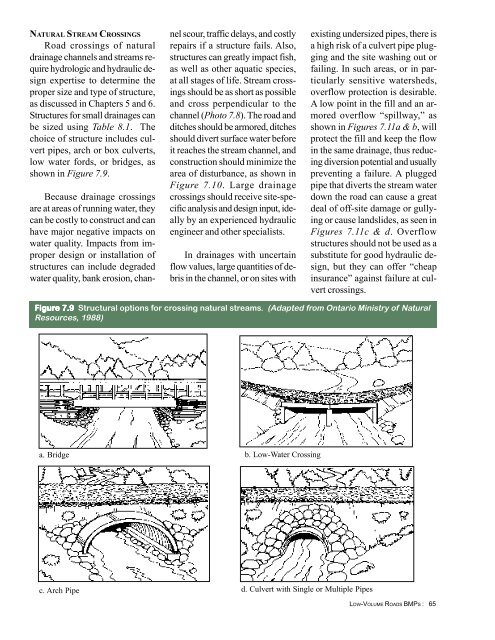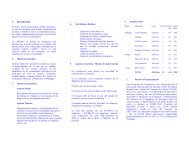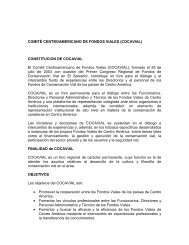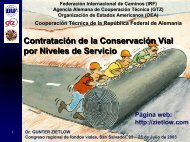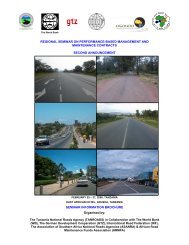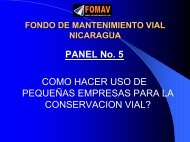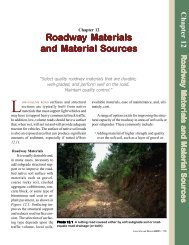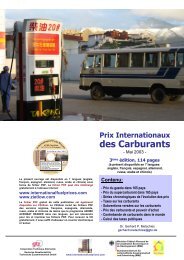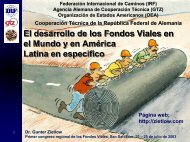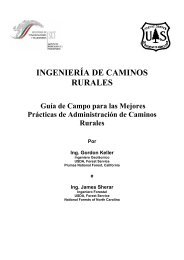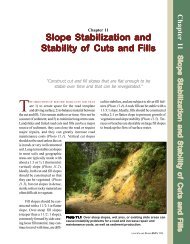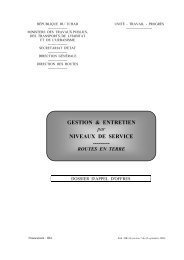Create successful ePaper yourself
Turn your PDF publications into a flip-book with our unique Google optimized e-Paper software.
NATURAL STREAM CROSSINGS<br />
Road crossings <strong>of</strong> natural<br />
drainage channels and streams require<br />
hydrologic and hydraulic design<br />
expertise to determine the<br />
proper size and type <strong>of</strong> structure,<br />
as discussed in <strong>Chapter</strong>s 5 and 6.<br />
Structures for small drainages can<br />
be sized using Table 8.1. The<br />
choice <strong>of</strong> structure includes culvert<br />
pipes, arch or box culverts,<br />
low water fords, or bridges, as<br />
shown in Figure 7.9.<br />
nel scour, traffic delays, and costly<br />
repairs if a structure fails. Also,<br />
structures can greatly impact fish,<br />
as well as other aquatic species,<br />
at all stages <strong>of</strong> life. Stream crossings<br />
should be as short as possible<br />
and cross perpendicular to the<br />
channel (Photo 7.8). The road and<br />
ditches should be armored, ditches<br />
should divert surface water before<br />
it reaches the stream channel, and<br />
construction should minimize the<br />
area <strong>of</strong> disturbance, as shown in<br />
Figure 7.10. Large drainage<br />
crossings should receive site-specific<br />
analysis and design input, ideally<br />
by an experienced hydraulic<br />
engineer and other specialists.<br />
In drainages with uncertain<br />
flow values, large quantities <strong>of</strong> debris<br />
in the channel, or on sites with<br />
existing undersized pipes, there is<br />
a high risk <strong>of</strong> a culvert pipe plugging<br />
and the site washing out or<br />
failing. In such areas, or in particularly<br />
sensitive watersheds,<br />
overflow protection is desirable.<br />
A low point in the fill and an armored<br />
overflow “spillway,” as<br />
shown in Figures 7.11a & b, will<br />
protect the fill and keep the flow<br />
in the same drainage, thus reducing<br />
diversion potential and usually<br />
preventing a failure. A plugged<br />
pipe that diverts the stream water<br />
down the road can cause a great<br />
deal <strong>of</strong> <strong>of</strong>f-site damage or gullying<br />
or cause landslides, as seen in<br />
Figures 7.11c & d. Overflow<br />
structures should not be used as a<br />
substitute for good hydraulic design,<br />
but they can <strong>of</strong>fer “cheap<br />
insurance” against failure at culvert<br />
crossings.<br />
Figur<br />
igure e 7.9 Structural options for crossing natural streams. (Adapted from Ontario Ministry <strong>of</strong> Natural<br />
Resources, 1988)<br />
Because drainage crossings<br />
are at areas <strong>of</strong> running water, they<br />
can be costly to construct and can<br />
have major negative impacts on<br />
water quality. Impacts from improper<br />
design or installation <strong>of</strong><br />
structures can include degraded<br />
water quality, bank erosion, chana.<br />
Bridge b. <strong>Low</strong>-Water Crossing<br />
c. Arch Pipe d. Culvert with Single or Multiple Pipes<br />
LOW-VOLUME ROADS BMPS : 65


